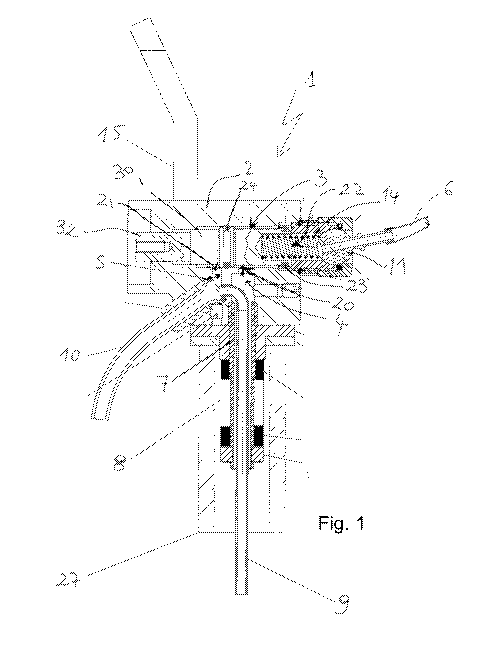Some of the information on this Web page has been provided by external sources. The Government of Canada is not responsible for the accuracy, reliability or currency of the information supplied by external sources. Users wishing to rely upon this information should consult directly with the source of the information. Content provided by external sources is not subject to official languages, privacy and accessibility requirements.
Any discrepancies in the text and image of the Claims and Abstract are due to differing posting times. Text of the Claims and Abstract are posted:
| (12) Patent Application: | (11) CA 2848644 |
|---|---|
| (54) English Title: | DISPENSING DEVICE FOR BEVERAGES |
| (54) French Title: | DISPOSITIF DE DISTRIBUTION POUR BOISSONS |
| Status: | Deemed Abandoned and Beyond the Period of Reinstatement - Pending Response to Notice of Disregarded Communication |
| (51) International Patent Classification (IPC): |
|
|---|---|
| (72) Inventors : |
|
| (73) Owners : |
|
| (71) Applicants : |
|
| (74) Agent: | NORTON ROSE FULBRIGHT CANADA LLP/S.E.N.C.R.L., S.R.L. |
| (74) Associate agent: | |
| (45) Issued: | |
| (86) PCT Filing Date: | 2012-07-16 |
| (87) Open to Public Inspection: | 2013-01-24 |
| Availability of licence: | N/A |
| Dedicated to the Public: | N/A |
| (25) Language of filing: | English |
| Patent Cooperation Treaty (PCT): | Yes |
|---|---|
| (86) PCT Filing Number: | PCT/IB2012/053622 |
| (87) International Publication Number: | WO 2013011445 |
| (85) National Entry: | 2014-03-13 |
| (30) Application Priority Data: | ||||||
|---|---|---|---|---|---|---|
|
A device (1) for dispensing liquids, particularly wine, from a bottle or similar container includes a body (2) designed to work with the neck (27) of the bottle and to cause the leakage of the liquid from a blowpipe (10) resulting from the supply in the bottle of an inert gas (eg. nitrogen) under pressure. Said body (2) comprises a first conduit (3), placed transversely and with a first opening (22) for the supply of the gas. Two further openings (20 and 21) are placed along the conduit (3) for connecting them with a second conduit (4) designed to supply the gas inside the bottle and, respectively, with a third conduit (5 ) provided with a blowpipe (10) for dispensing the liquid.
L'invention porte sur un dispositif (1) pour distribuer des liquides, en particulier du vin, à partir d'une bouteille ou d'un récipient similaire, lequel dispositif comprend un corps (2) conçu pour fonctionner avec le col (27) de la bouteille et pour provoquer la fuite du liquide à partir d'un tuyau de soufflage (10) résultant de la fourniture dans la bouteille d'un gaz inerte (par exemple de l'azote) sous pression. Ledit corps (2) comprend un premier conduit (3), disposé transversalement et avec une première ouverture (22) pour la fourniture du gaz. Deux autres ouvertures (20 et 21) sont disposées le long du conduit (3) pour relier celles-ci à un second conduit (4) conçu pour fournir le gaz à l'intérieur de la bouteille, et, respectivement, à un troisième conduit (5) comportant un tuyau de soufflage (10) pour distribuer le liquide.
Note: Claims are shown in the official language in which they were submitted.
Note: Descriptions are shown in the official language in which they were submitted.

2024-08-01:As part of the Next Generation Patents (NGP) transition, the Canadian Patents Database (CPD) now contains a more detailed Event History, which replicates the Event Log of our new back-office solution.
Please note that "Inactive:" events refers to events no longer in use in our new back-office solution.
For a clearer understanding of the status of the application/patent presented on this page, the site Disclaimer , as well as the definitions for Patent , Event History , Maintenance Fee and Payment History should be consulted.
| Description | Date |
|---|---|
| Application Not Reinstated by Deadline | 2016-07-18 |
| Time Limit for Reversal Expired | 2016-07-18 |
| Deemed Abandoned - Failure to Respond to Maintenance Fee Notice | 2015-07-16 |
| Inactive: Cover page published | 2014-04-29 |
| Inactive: Notice - National entry - No RFE | 2014-04-17 |
| Inactive: IPC assigned | 2014-04-15 |
| Inactive: First IPC assigned | 2014-04-15 |
| Application Received - PCT | 2014-04-15 |
| National Entry Requirements Determined Compliant | 2014-03-13 |
| Application Published (Open to Public Inspection) | 2013-01-24 |
| Abandonment Date | Reason | Reinstatement Date |
|---|---|---|
| 2015-07-16 |
The last payment was received on 2014-07-10
Note : If the full payment has not been received on or before the date indicated, a further fee may be required which may be one of the following
Please refer to the CIPO Patent Fees web page to see all current fee amounts.
| Fee Type | Anniversary Year | Due Date | Paid Date |
|---|---|---|---|
| Basic national fee - standard | 2014-03-13 | ||
| Reinstatement (national entry) | 2014-03-13 | ||
| MF (application, 2nd anniv.) - standard | 02 | 2014-07-16 | 2014-07-10 |
Note: Records showing the ownership history in alphabetical order.
| Current Owners on Record |
|---|
| FRANCESCA BARNINI |
| Past Owners on Record |
|---|
| None |